As the dust finally settles on what was a confusing season for Chelsea in 2018/19, a calming window for reflection emerges. A season filled largely with disdain and public shaming turned into something of a success story. Maurizio Sarri and his men battled to an unexpected third-place finish, a League Cup silver medal before lifting the Europa League trophy in Baku.
Chelsea were criticised for losing their identity and playing a brand of football not in line with the club’s ethos. Sarri struggled to find the hallowed balance between entertainment and success, and so was sacked, adding his name to the graveyard of coaches that have fallen before him. But much like the Stamford Bridge turf ripped out at the end of May, a time for regrowth has arrived at the London club.
This tactical analysis will review the highs and lows of the Blue’s turbulent season. The analysis will be a season preview highlighting where Chelsea will need to improve as they move into a new era at the club.
2018/19 Review: A season in numbers
Chelsea finished their season on a high, taking the title of being the best side in an inconsistent chasing pack. The Blues started the season with intent, only losing three games before the New Year. In this time Chelsea racked up 13 wins and conceded just 16 goals, taking them to 4th in the table.
It was from January where the London club struggled, picking up a mere 23 points from the 54 available. A combination of over-reliance on Eden Hazard, an out of form Gonzalo Higuaín and a sluggish tactical build-up play saw the Blues struggle in front of goal. Chelsea managed to score a sorry 25 goals in this period – fewer than Bournemouth who finished 16th.
But, typical of Sarri’s reign, the Europa League winners did exactly what they were expected to do. Chelsea’s xPTS (Expected Points) differential was the closest to their actual total out of any other club. They finished the season on 72 points and were expected 71.45 based on their chances created and conceded.
Much like their manager’s approach, the statistics demonstrate a season based on logic and strategy; Chelsea won and lost games when they should have. Ultimately this was their perceived problem; too much precision, not enough chaos.
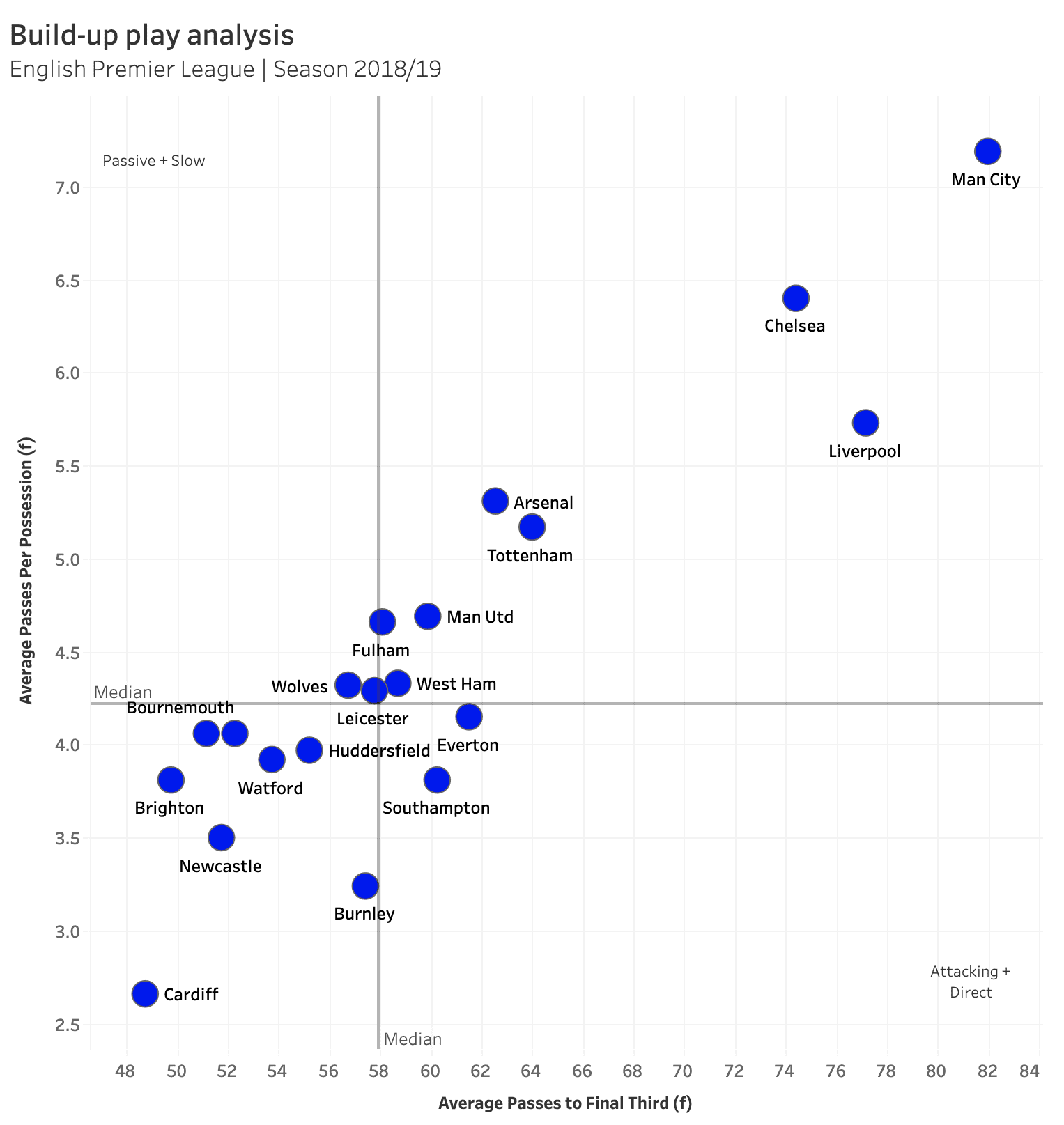
The statistics show that despite their critics, Chelsea were ahead of the pack when it came to progressive attacking play. Sarri’s men averaged 74.41 passes per game into the final third, the third-highest in the league. They also enjoyed dominating the ball, with an average possession of 61.91% in the Premiership, and 6.4 passes per possession on average, higher than Liverpool (5.73).
What worked well: defending
Despite the goals not coming as freely as those in the table they kept company with, Chelsea were able to muscle themselves to a third-place finish. They did this with a resilient back four that only conceded 39 goals. This was thanks to the system introduced by Sarri which offered plenty of defensive support when out of possession.
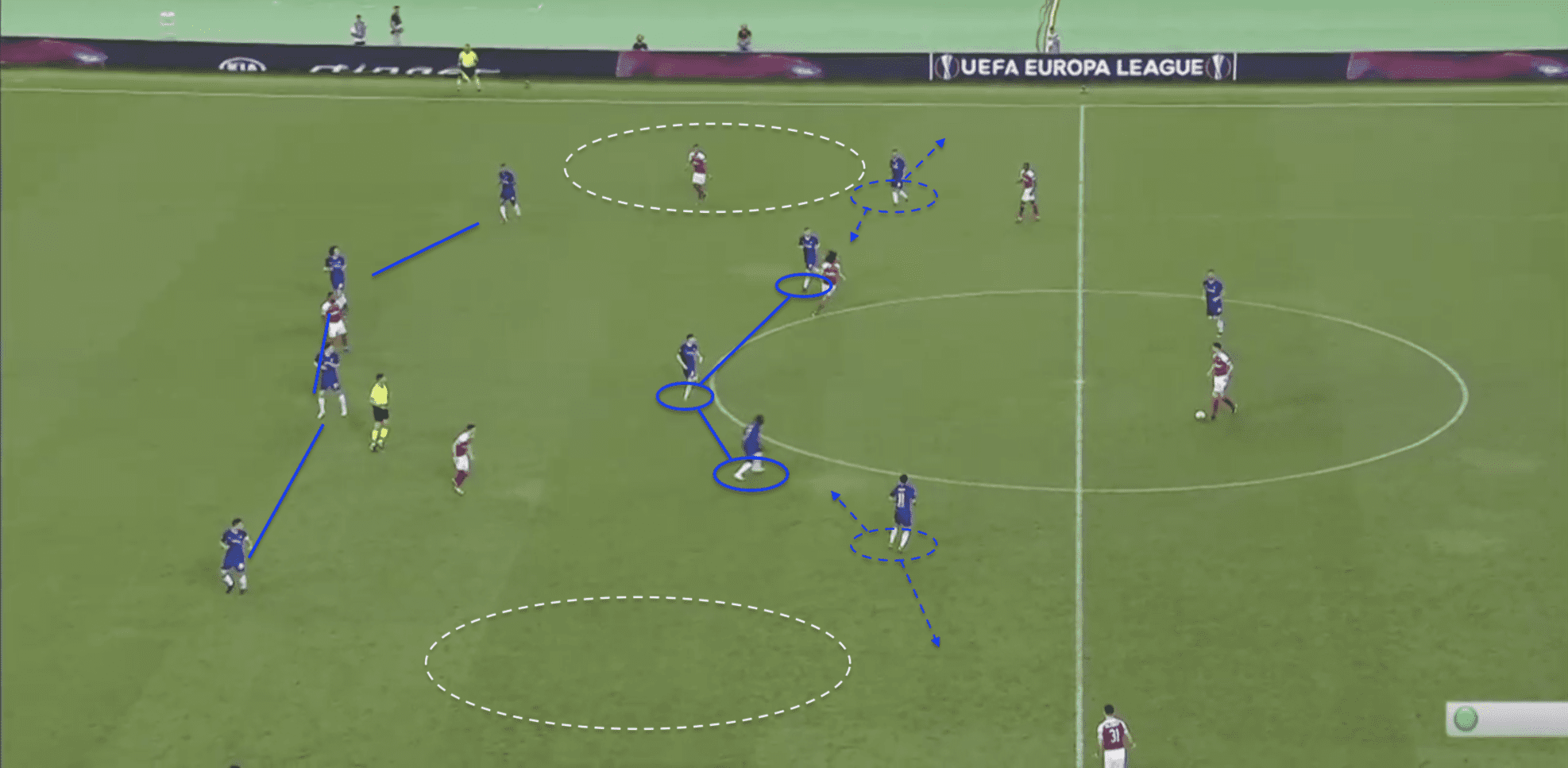
In Sarri’s preferred 4-3-3 – a shape they used 97% of the time in all competitions in 2018/19 – Chelsea operated a deeper block. Jorghino acted as the deep-lying playmaker and was the central point in their system. Out of possession, N’Golo Kanté and Mateo Kovačić tucked in alongside Jorhingo to block passing lanes through the centre of Chelsea’s midfield. This movement funnelled the ball into the wider, safer spaces. Upon this ball being played, the respective winger, full-back and central midfielder moved across followed by a shift in the defensive unit. This prevented overloads occurring in the lateral areas. As a result, teams found it difficult to break Chelsea down.
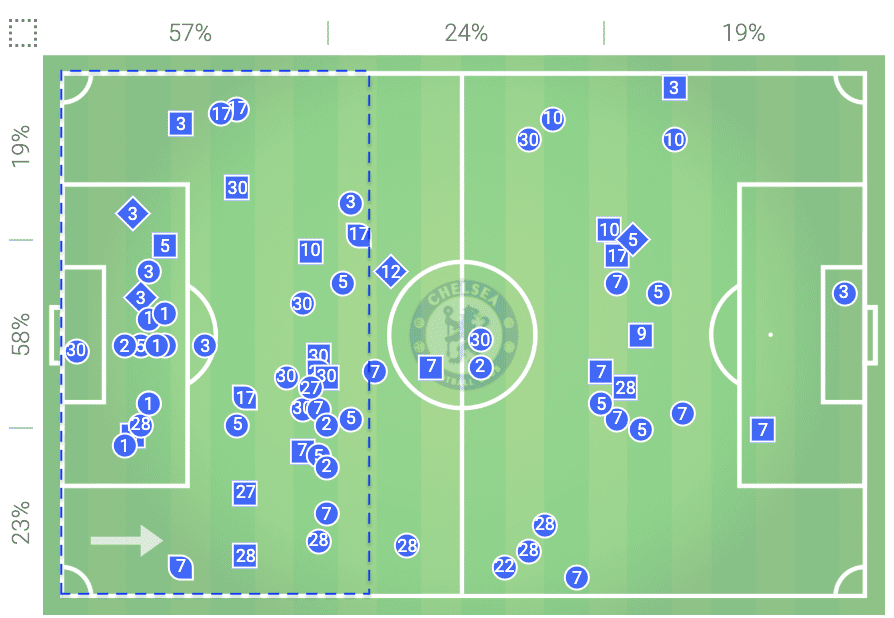
The recovery map above is typical of a Chelsea defensive performance in 2018/19. The majority of their recoveries occurred from a deeper block. A massive 57% from their defensive third in the match against Man United.
Chelsea opted not to initiate an aggressive press like their rivals, instead choosing stability and a solid base to defend from. This shouldn’t be confused with a passive strategy as we see below.
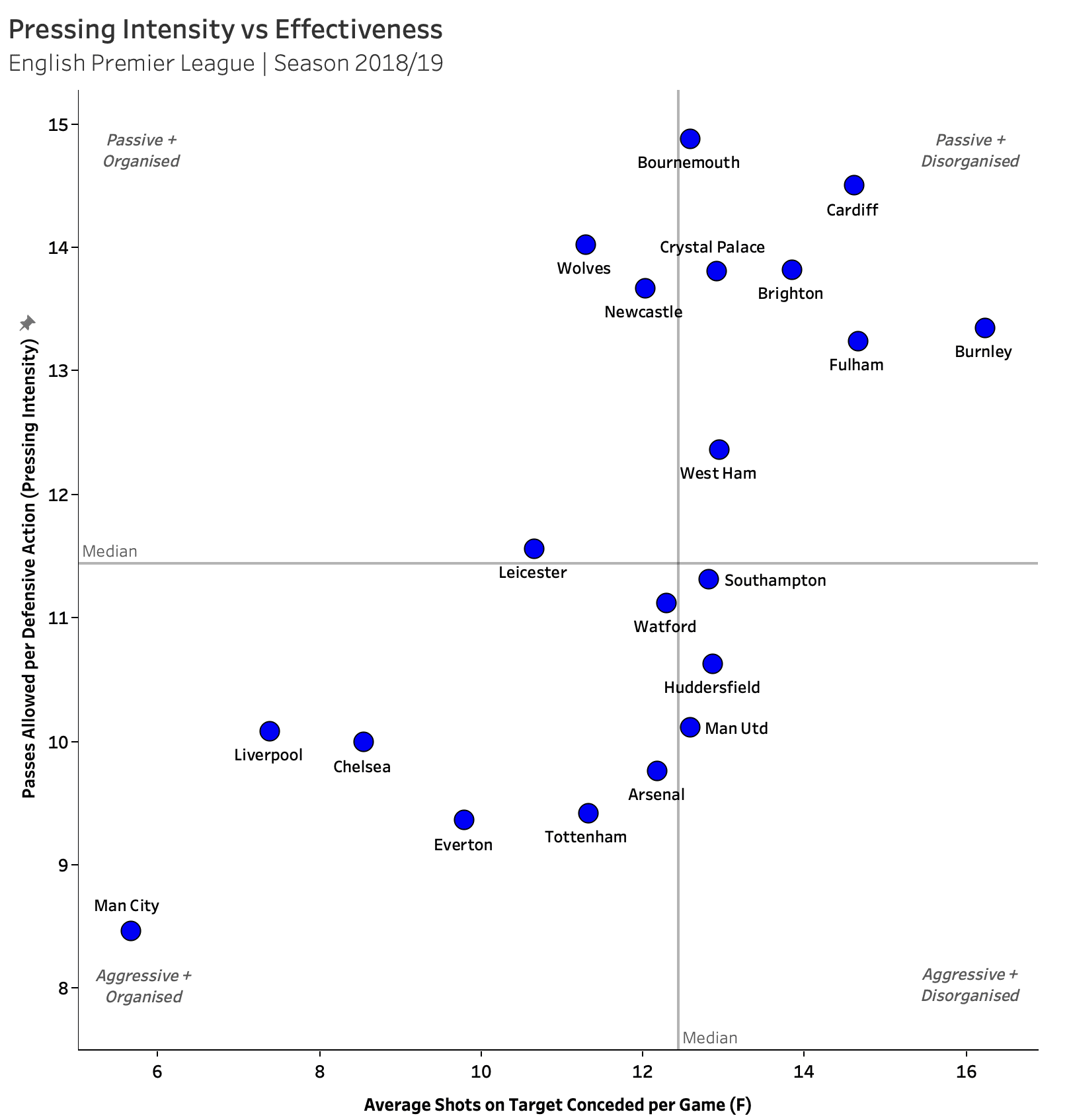
The graph above showcases the pressing intensity from each side in the Premier League and reviews the effectiveness of the tactics deployed. The chart measures the passes allowed per defensive action (PPDA) against the average number of shots conceded per game. Chelsea only allowed on average 8.55 shots on target per game, the third-lowest in the league. They did this by using a solid defensive foundation as reviewed above.
However, the graph shows that Chelsea only allowed 9.9 PPDA, which indicates that once the passes were channelled into designated areas, the Blues were aggressive in winning the ball back.
With no major sales happening in the defensive ranks of Chelsea’s squad, Frank Lampard has a solid foundation to build upon next season. Below we take a look at what to expect from Stamford Bridge next season.
Looking ahead to 2019/20
Much like Sarri, Lampard enjoys using variants of the 4-3-3. Last season Derby adopted a 4-3-3 system or similar 77% of the time. This will benefit the Chelsea squad as they transition and adapt to their new manager’s ideas.
However, with their transfer ban in full force, Chelsea have some major adjustments to make. These are problems that cannot be fixed with a Russian chequebook.
The Hazard factor
Eden Hazard took his game to another level last season. The Belgian international showed the true extent of his talents that are admired by so many. His strength and ability on the ball was a constant threat to defenders as he single-handedly won games for Chelsea last year. Hazard was the only Chelsea player to score over 10 goals last season and he was personally responsible for 14 points in Chelsea’s total. Putting it another way; without Hazard’s contribution, Chelsea would have finished outside the top six.
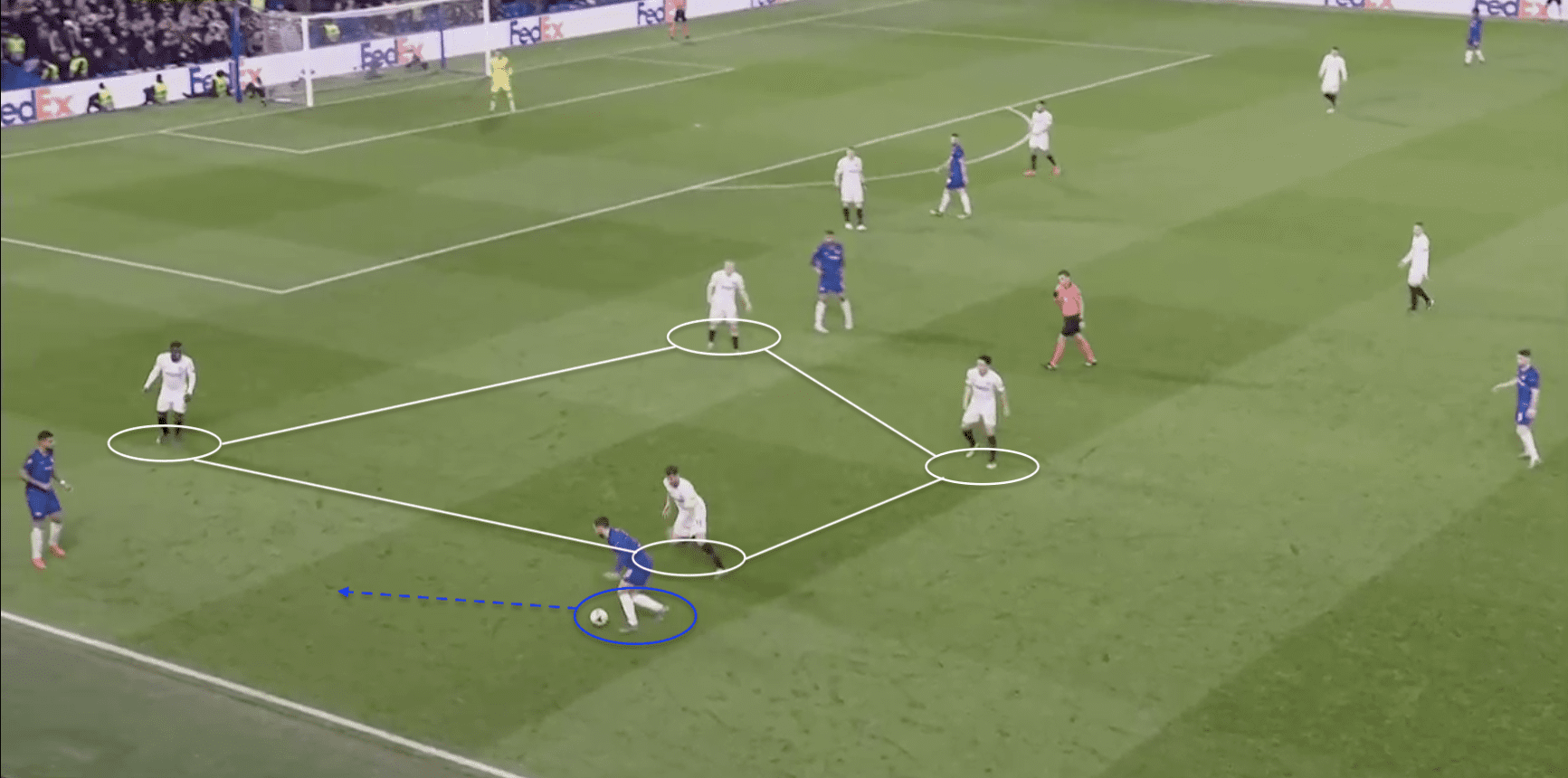
Due to Chelsea’s slower build-up play, their opposition had time to organise themselves defensively. Ball rotations alone were not enough to break down well-drilled teams and Chelsea often relied on Hazard to create space where none existed.
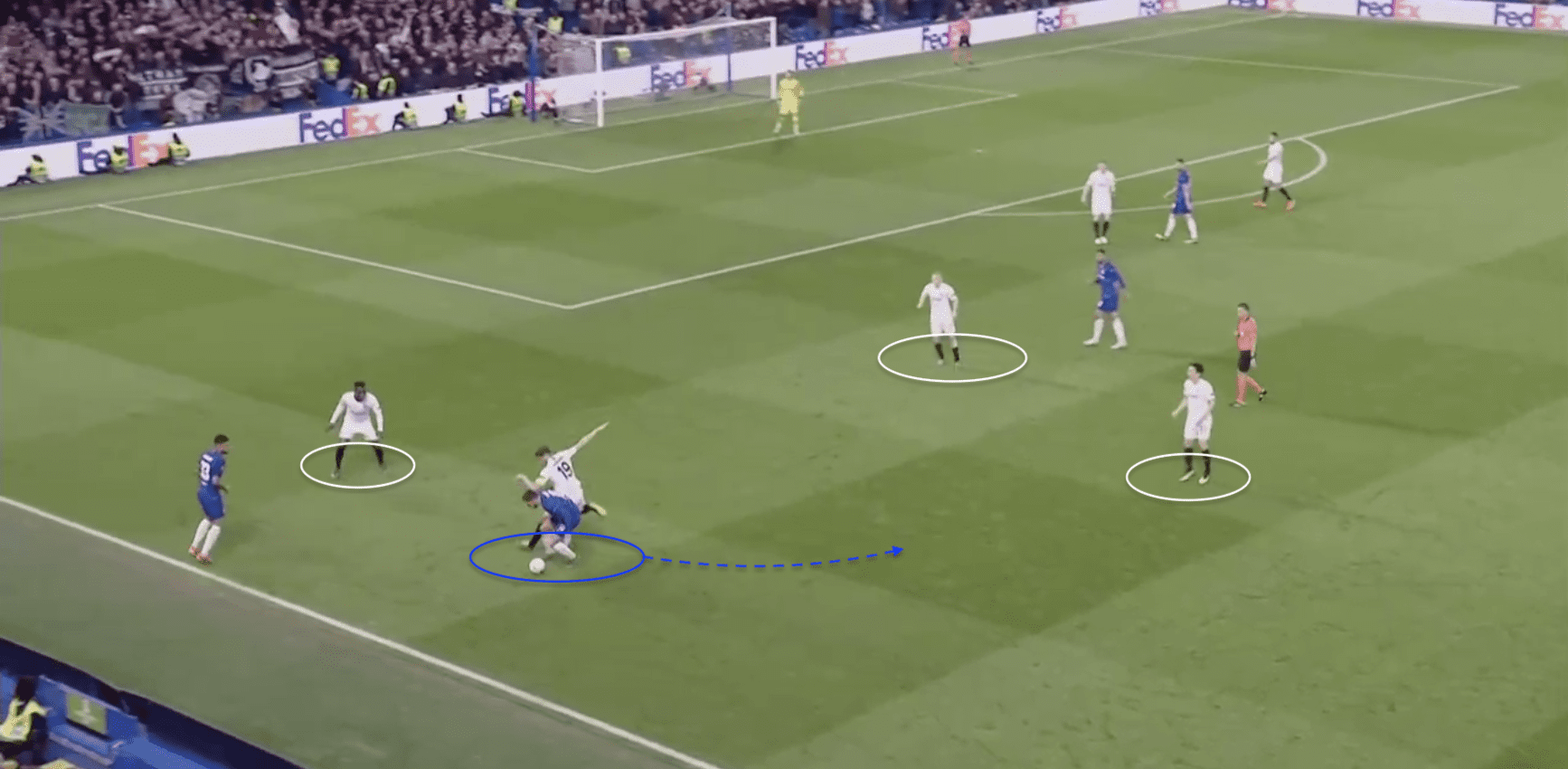
Using his strength and low centre of gravity to turn sharply, defenders struggled to get the ball from Hazard once he began to dribble. This drew other defenders in as they attempted to offer support to their tormented teammate. In doing so, spaces opened up off the ball, which Chelsea players identified and moved into.
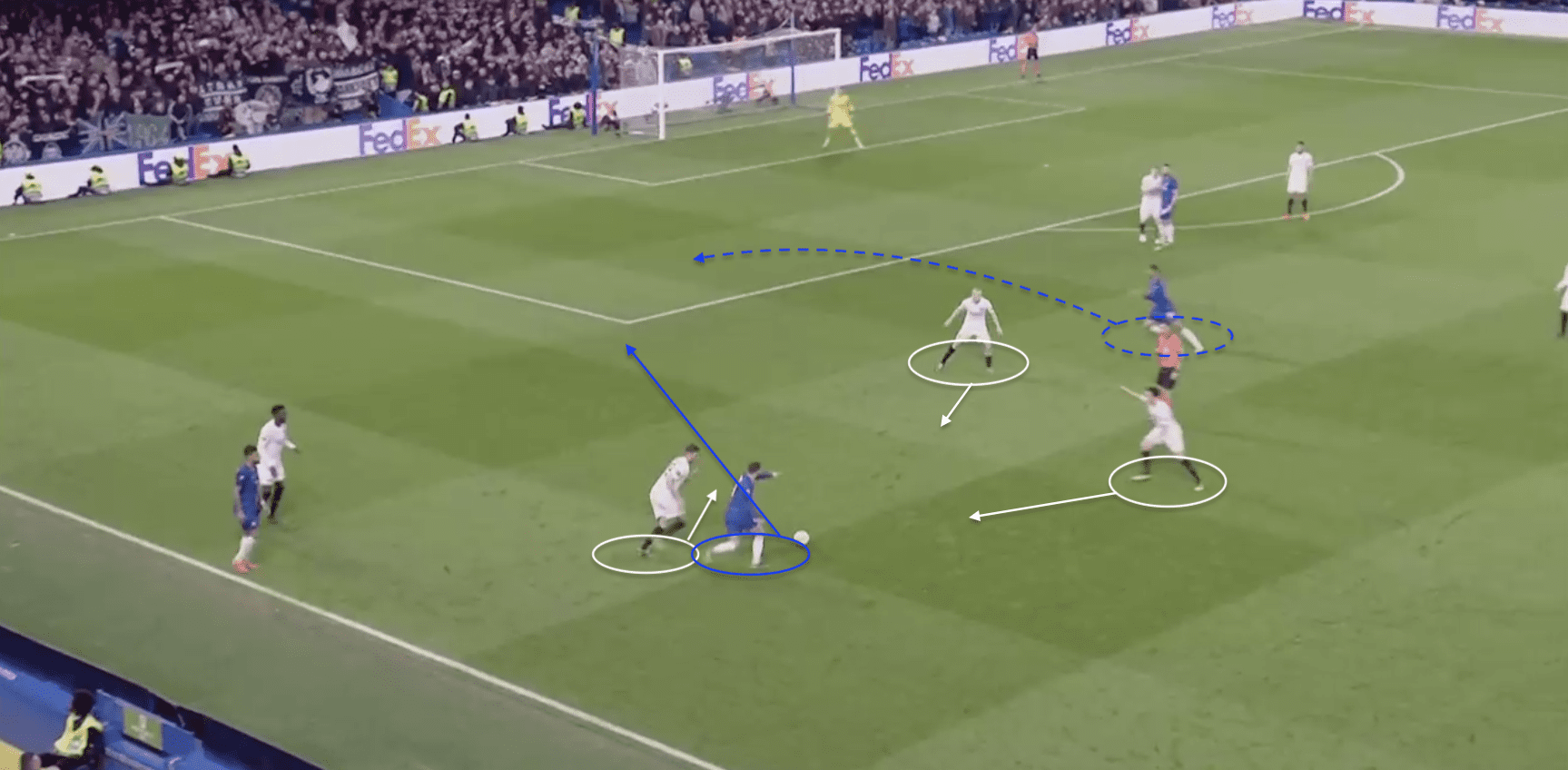
Hazard had the ability to hold onto the ball long enough for other players to identify the spaces he created from his penetrative dribbling. To follow-up, he used his vision and spacial awareness to play a defence-splitting pass which turned into an assist.
Last season Hazard finished with 15 assists and scored 16 himself. This meant he contributed to 49.7% of Chelsea’s total goals in the Premier League. Christian Pulisic is the unfortunate man who has been signed to replace the departing Belgian. However being untested in the Premier League, to produce a season of that calibre, in his first season, would be nothing short of spectacular.
Therefore, this is a chasm Lampard will need to fill using other methods if Chelsea are looking to challenge for the top four again next season.
A vacant number nine role
With Higuaín departing the 5-time league champions number nine spot is up for grabs. First in line, and desperate for a chance is the French international Olivier Giroud. The 32-year-old topped the Europa League goal scoring charts last season with an impressive 11 goals.
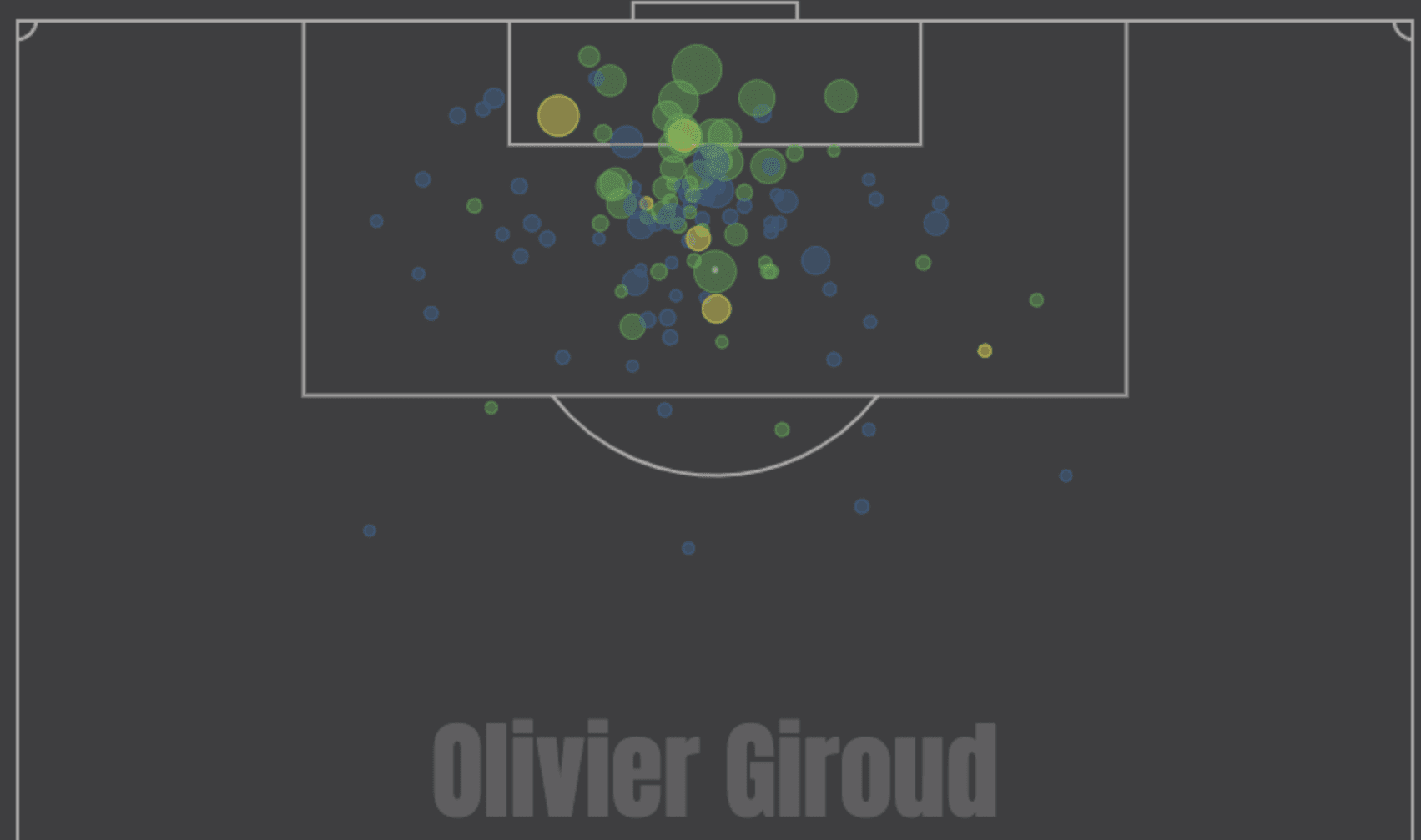
Giroud is a penalty box striker that thrives off dangerous deliveries from wide areas. As you can see above, the majority of Giroud’s chances/goals come from inside the penalty area. Last season in the Europa League, Chelsea were averaging 15.67 crosses per game at a 31.9% success rate. This was to involve the Frenchman as much as possible, which worked to great effect.
If Lampard is to get the best out of their new main striker he will have to adjust his tactics. Derby last year only averaged 14.14 crosses, as their style favoured a more passive build-up with a preference to shooting from range. Lampard will need to devise a way to incorporate the skill set of Giroud if he is looking to reduce the goal deficit left by Hazard.
Conclusion
Despite the issues this scout report has raised, Chelsea have a great opportunity to dip into their well-stocked youth system. Players who have been used as loan fodder now have a chance to break into an ageing first team without a multi-million-pound signing to contend with. Callum-Hudson-Odoi, Pulisic and Tammy Abraham are all exciting talents, who given the time can develop into Premier League standard players.
However, to ask these inexperienced players to adjust to a new style as well as make up the balance of goals left by Hazard appears to be tall order. Instead of initiating a media frenzy at the first sign of trouble, the Chelsea hierarchy should instead view this season as a development year. It’s important they are not too quick to yield the axe on a squad that is in an important stage of a transitional cycle.
A successful season should start with a seamless transition into a new era, and build on the positives from there. By heaping minimum expectations onto a new manager with a new side is only going to fuel the managerial merry-go-round that Chelsea fans are desperate to stop riding.
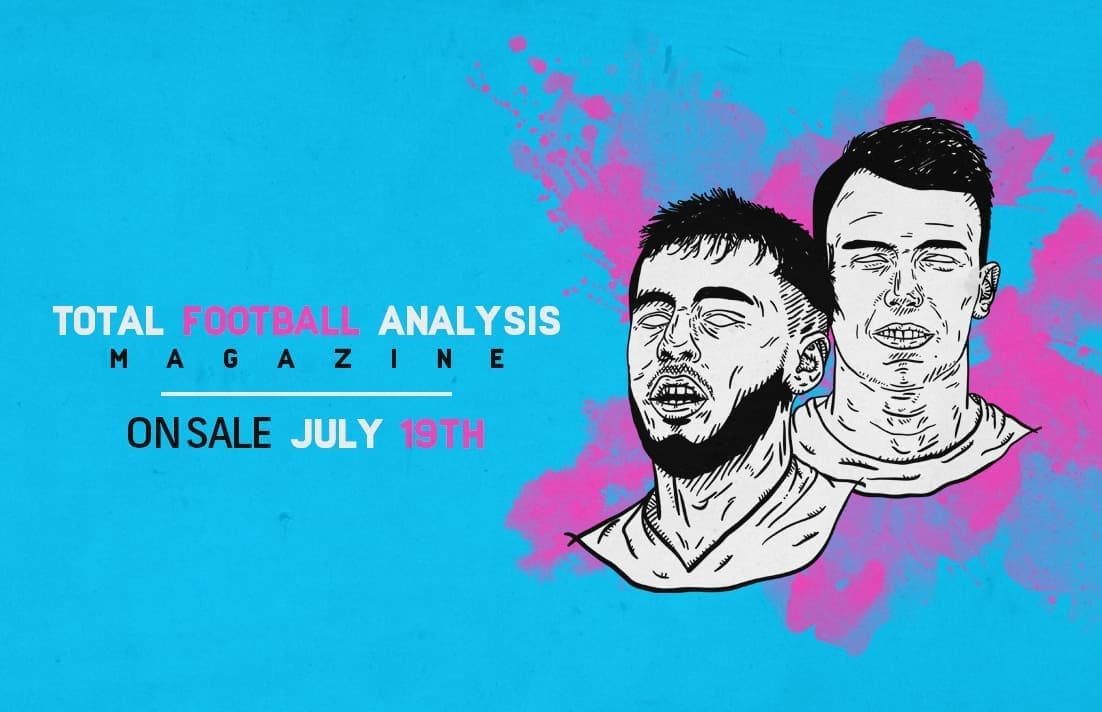
If you love tactical analysis, then you’ll love the digital magazines from totalfootballanalysis.com – a guaranteed 100+ pages of pure tactical analysis covering topics from the Premier League, Serie A, La Liga, Bundesliga and many, many more. Buy your copy of the July issue for just ₤4.99 here, or even better sign up for a ₤50 annual membership (12 monthly issues plus the annual review) right here.

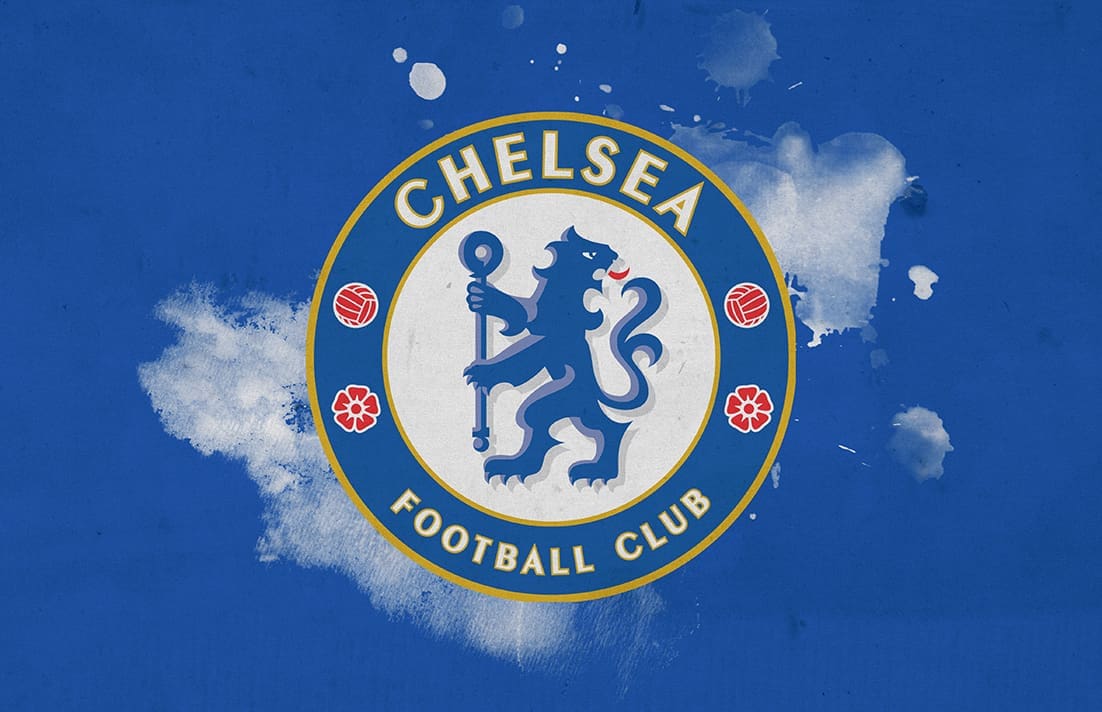



Comments